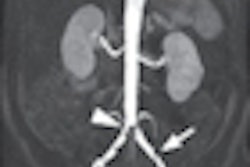
NEW YORK (Reuters Health), May 24 - Diffusion-weighted imaging with the newer 3.0-tesla MRI equipment may be less accurate than with the older 1.5-tesla scanners for detecting stroke lesions within the first six hours after onset, a new French study suggests.
Increasingly, neuroradiology departments are equipped with 3.0-tesla MR units, Dr. Charlotte Rosso and colleagues from Pitie-Salpetriere Hospital in Paris point out in the June 15 issue of Neurology, available online now. These units have a better signal-to-noise ratio but are more susceptible to image artifacts due to increased field strength, they note.
Dr. Rosso's team compared the sensitivity and specificity of 1.5-tesla and 3.0-tesla diffusion-weighted MRI (DWI) to detect hyperacute ischemic stroke lesions. Two neuroradiologists and two stroke neurologists reviewed DWI of 135 acute stroke patients and 34 controls, without knowing whether MRI was performed at 1.5 tesla (n = 108) or 3.0 tesla (n = 61). All stroke patients had carotid territory ischemic stroke and were imaged within six hours after onset.
The performance between neuroradiologists and stroke neurologists did not differ significantly.
The authors found DWI was more accurate for early stroke diagnosis at 1.5 tesla than at 3.0 tesla (98.8% vs 90.9%, p = 0.03). The sensitivity decreased from 99.1% at 1.5 tesla to 92.5% at 3.0 tesla (p = 0.06) and the specificity from 97.8% to 84.1% (p = 0.002).
The false-positive rate was 0.6% at 1.5 tesla and 6.1% at 3.0 tesla.
Based on their findings, the researchers estimate that one out of 16 acute stroke patients will have a negative DWI at 3.0 tesla during the therapeutic window, versus less than one out of 100 at 1.5 tesla.
"Interestingly," they wrote, in multivariate analysis the higher false-negative rate was not related to potential confounders such as type of reader (neuroradiologist or stroke neurologist) or stroke severity, "but was only predicted by 3.0 tesla versus 1.5 tesla and as expected shorter imaging delay since stroke onset."
Apparent diffusion coefficient maps, which were provided to reviewers in cases of an uncertain diagnosis, did not significantly improve diagnostic accuracy, "although it led to more changes in diagnosis at 3.0 tesla than 1.5 tesla."
Despite significantly higher signal-to-noise ratio at 3.0 tesla (p < 0.0001), the DWI contrast was 18% lower at 3.0 tesla than at 1.5 tesla (p = 0.04). This, the authors say, suggests that acute ischemic diffusion changes "may be less visible at 3.0 tesla than at lower magnetic field, and thus may have contributed to the lower diagnostic power of 3.0-tesla imaging."
http://www.neurology.org/cgi/content/abstract/WNL.0b013e3181e396d1v1
Neurology 2010.
Last Updated: 2010-05-24 9:00:34 -0400 (Reuters Health)
Related Reading
Resting fMRI exam may predict stroke and brain injury outcomes, March 30, 2010
Copyright © 2010 Reuters Limited. All rights reserved. Republication or redistribution of Reuters content, including by framing or similar means, is expressly prohibited without the prior written consent of Reuters. Reuters shall not be liable for any errors or delays in the content, or for any actions taken in reliance thereon. Reuters and the Reuters sphere logo are registered trademarks and trademarks of the Reuters group of companies around the world.

















